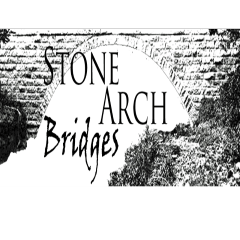Stone masonry can be learned well with experience and regular practice. The two basic classes of stone masonry are mortared and mortarless. Mortared masonry is easier, as stone-fitting does not have to be quite as precise, and much time is saved in not having to shim up each stone. However, it is always a good idea to practice initially with temporary mortarless structures, to get the feel for stacking stones to stay.
Practice Structures
Mortar is not to be used as glue. It acts to distribute the weight of each stone evenly to those below. Therefore, the stones ought to tend to stay in place mortared or not. Practicing building sturdy mortarless structures is a good start to building. Practice laying stones such that joints are broken with a stone above. This means laying a stone over the vertical seam formed between two stones below resting next to each other in their course, and such that they fit reasonably well on their own or with some basic shimming.

Small experimental arches can be built in this fashion as well. In fact, that is how we got started, building numerous small arches with small rocks. In the process, we found common weak points and failures, and ways to build them stronger, which came in handy down the road.
Mortar: Not a “Wall Glue”
A good mortared structure should be inherently stable, even without the mortar. The stones should break joints, and really ought to be shimmed up, at least basically, so they are not inherently wobbly. There is nothing wrong with using shims around a stone in a mortared structure; in fact this makes the structure stronger and saves on mortar. Care will need to be taken to prevent chemical burns or at least skin dehydration from contact with the mortar; perhaps use thick rubberized gloves? The mortar merely helps distribute the structure’s weight, and also eliminates the constant flexing of a wall from frost. Hence, mortar makes a structure more forgiving in some aspects, but does not replace good work. It should never be relied on to actually suspend a stone in place. Mortar’s bond is limited, and cannot really be relied on under tensile forces. Of course, since mortar does still bond with the stones, it can help prevent stones from being dislodged from impacts, but this is more of an added benefit as opposed to something to rely on.
Practice Makes Perfect
At the time of this post, we are completing our third stone arch bridge. It is always interesting how, when it comes down to it, each bridge is a little better than the one that came before.

The best way to become skilled at masonry is to practice. It is worth pointing out that many builders have their own methods, which gives their structures a hallmark appearance. There is nothing wrong with having your own method. In fact, as long as some basic fundamentals are met, there really is no right or wrong way to build masonry. The key is to ensure each stone fits well in place regardless of whether or not if mortar is used. This can be done with shims, but as one becomes more skilled, you will rely on shims less and less to stabilize stones. Cutting stones for a better fit is another technique that requires practice, but can also be mastered with time.
Fundamentals
The basic fundamentals of masonry help ensure a long-lived structure. These are, for the most part, not hard-and-fast rules that must be followed strictly lest doom overtake the structure. Rather, they are tried-and-true ways for building stronger, more enduring structures. A classic example is the “no vertical running joint” rule. Vertical running joints are formed when a several courses are laid above each other such that the joints of each course are more or less laid in a vertical line with the ones below. This does make the structure weaker, as, in the case of a wall, it turns the structure into two separate walls that meet but do not bond with each other. However, one will still find old structures actively being used that nevertheless feature prominent running joints.

Running joints really ought to be avoided, but a running joint, especially if limited to a single “run” between two courses, does not necessarily spell failure. In the end how long the structure lasts under its intended purpose is the real test of a mason’s work.
Quality Structures
There are many masonry structures that are impressively old. In the United States of America, the east coastal region features numerous mortarless granite bridges featuring many impossibly shaped stones, and yet these bridges are decidedly over a century old. Even though some of these structures may be classified as “poor-quality construction” they still remain in use with some basic maintenance. It is important to realize that masonry (including arch building) is not a mysterious art, but a simple skill that can be honed with practice. Many masons of enduring structures across the country were not actually “professional” masons, but were rather often local people seeking to build a practical structure for everyday use. Anyone can do stonework with a little practice. Stone masonry is a rewarding undertaking.

